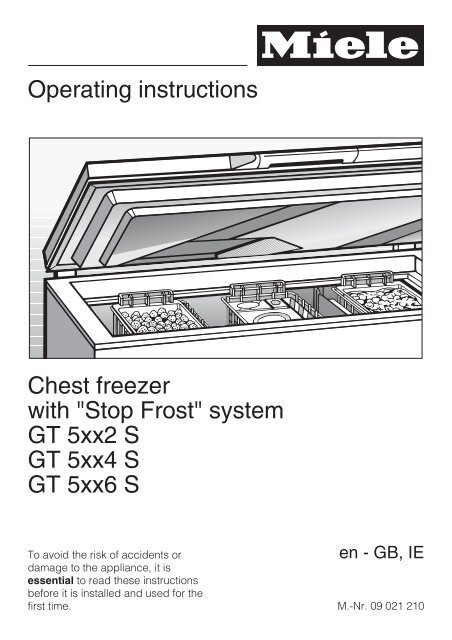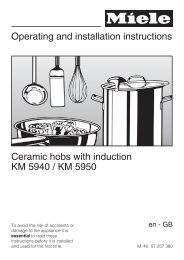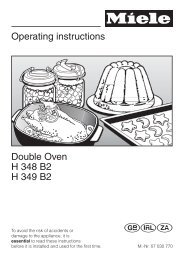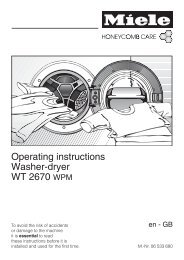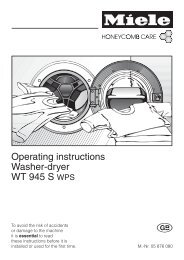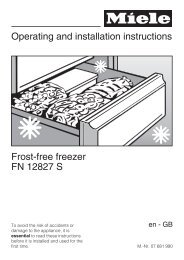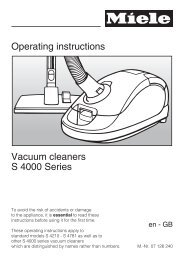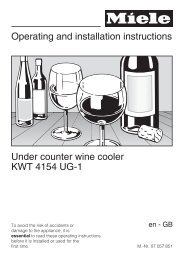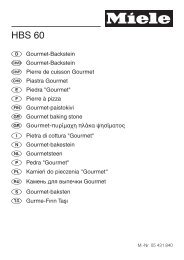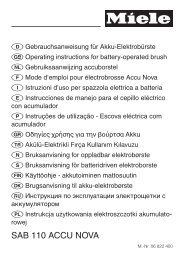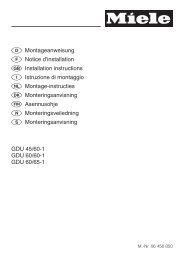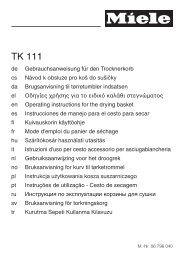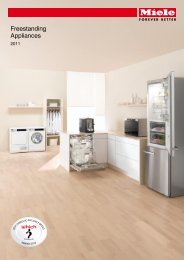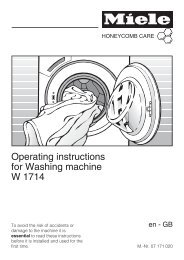Operating instructions Chest freezer with "Stop Frost" system ... - Miele
Operating instructions Chest freezer with "Stop Frost" system ... - Miele
Operating instructions Chest freezer with "Stop Frost" system ... - Miele
Create successful ePaper yourself
Turn your PDF publications into a flip-book with our unique Google optimized e-Paper software.
<strong>Operating</strong> <strong>instructions</strong><br />
<strong>Chest</strong> <strong>freezer</strong><br />
<strong>with</strong> "<strong>Stop</strong> Frost" <strong>system</strong><br />
GT 5xx2 S<br />
GT 5xx4 S<br />
GT 5xx6 S<br />
To avoid the risk of accidents or<br />
en - GB, IE<br />
damage to the appliance, it is<br />
essential to read these <strong>instructions</strong><br />
before it is installed and used for the<br />
first time. M.-Nr. 09 021 210
Contents<br />
Guide to the appliance .............................................4<br />
Caring for the environment. .........................................6<br />
Warning and Safety <strong>instructions</strong> .....................................7<br />
How to save energy ...............................................12<br />
Switching on and off ..............................................13<br />
Switching off for longer periods of time .................................14<br />
The correct temperature ...........................................15<br />
Setting the temperature .............................................15<br />
Temperature alarm. ...............................................17<br />
Activating the alarm <strong>system</strong>. .........................................17<br />
Super freeze .....................................................18<br />
Super freeze .....................................................18<br />
Interior. .........................................................19<br />
Baskets .........................................................19<br />
Separate freezing section ...........................................20<br />
Freezing and storing food. .........................................21<br />
Maximum freezing capacity. .........................................21<br />
Freezing fresh food ................................................21<br />
Storing frozen food ................................................21<br />
Home freezing ....................................................22<br />
Hints on home freezing. ..........................................22<br />
Packing ......................................................22<br />
Before placing food in the <strong>freezer</strong> ..................................23<br />
Placing food in the <strong>freezer</strong> ........................................23<br />
Defrosting .......................................................23<br />
Cooling drinks ....................................................24<br />
Freezer tray ......................................................24<br />
Cool pack. .......................................................24<br />
Defrosting .......................................................25<br />
"<strong>Stop</strong> Frost" <strong>system</strong> ................................................25<br />
Cleaning and care ................................................27<br />
Cleaning the outer casing, the interior and accessories ....................27<br />
Ventilation gap ....................................................27<br />
Freezer lid seal ...................................................27<br />
2
Contents<br />
Problem solving guide ............................................29<br />
Noises .........................................................31<br />
After sales service ................................................32<br />
Electrical connection. .............................................33<br />
Installation ......................................................34<br />
Location .........................................................34<br />
Climate range ..................................................34<br />
Ventilation .......................................................35<br />
Appliance Dimensions. .............................................36<br />
3
Guide to the appliance<br />
a In-operation indicator light<br />
b Alarm indicator light<br />
e Control panel integrated in the<br />
handle<br />
f Interior lighting<br />
g Lock *<br />
4<br />
c Super freeze button <strong>with</strong> indicator<br />
light<br />
d On/Off and temperature selector<br />
h Ventilation gap<br />
i Defrosting outlet<br />
* depending on model
Lock<br />
(depending on model)<br />
The lock is fitted <strong>with</strong> a safety<br />
mechanism:<br />
^ Press and hold the a button.<br />
^ Turn the key 90°clockwise.<br />
The <strong>freezer</strong> is now locked.<br />
To unlock the <strong>freezer</strong>, turn the key 90°<br />
anti-clockwise.<br />
Guide to the appliance<br />
5
Caring for the environment<br />
Disposal of the packing<br />
material<br />
The transport and protective packing<br />
has been selected from materials which<br />
are environmentally friendly for<br />
disposal, and should be recycled.<br />
Ensure that any plastic wrappings,<br />
bags etc. are disposed of safely and<br />
kept out of the reach of babies and<br />
young children. Danger of suffocation!<br />
6<br />
Disposal of your old appliance<br />
Electrical and electronic appliances<br />
often contain materials which, if<br />
handled or disposed of incorrectly,<br />
could be potentially hazardous to<br />
human health and to the environment.<br />
They are, however, essential for the<br />
correct functioning of your appliance.<br />
Please do not therefore dispose of it<br />
<strong>with</strong> your household waste.<br />
Please dispose of it at your local<br />
community waste collection / recycling<br />
centre or contact your dealer for<br />
advice. Ensure that it presents no<br />
danger to children while being stored<br />
for disposal.<br />
Take care not to damage the pipework<br />
at the back of it before or during<br />
transportation to an authorised<br />
collection depot.<br />
In this way, refrigerant in the pipework<br />
and oil in the compressor will be<br />
contained and will not leak out into the<br />
environment.
Warning and Safety <strong>instructions</strong><br />
This appliance complies <strong>with</strong> all<br />
relevant legal safety requirements.<br />
Improper use can, however, present<br />
a risk of both personal injury and<br />
damage to property.<br />
To avoid the risk of accidents and<br />
damage to the appliance, please<br />
read these <strong>instructions</strong> carefully<br />
before installation and before using<br />
it for the first time. They contain<br />
important notes on the installation,<br />
safety, operation and care of the<br />
appliance.<br />
Keep these <strong>instructions</strong> in a safe<br />
place and pass them on to any<br />
future user.<br />
Correct application<br />
~ This appliance is not designed for<br />
commercial use. It is intended for use in<br />
domestic households and in similar<br />
working and residential environments<br />
such as:<br />
– Shops<br />
– Offices and showrooms<br />
and by residents in establishments<br />
such as:<br />
– Hostels and guest houses.<br />
It must only be used to store deep<br />
frozen food, freeze fresh food, and to<br />
make ice.<br />
Any other usage is not supported by<br />
the manufacturer and could be<br />
dangerous. <strong>Miele</strong> cannot be held liable<br />
for damage resulting from the incorrect<br />
or improper use of the appliance.<br />
~ This appliance is not intended for<br />
use by people <strong>with</strong> reduced physical,<br />
sensory or mental capabilities, or lack<br />
of experience and knowledge, unless<br />
they are supervised whilst using it, or<br />
have been shown how to use it<br />
correctly by a person responsible for<br />
their safety.<br />
Safety <strong>with</strong> children<br />
~ This appliance is not a toy! To avoid<br />
the risk of injury or damage to the<br />
appliance, do not allow children to play<br />
on or near it, and do not let them hang<br />
from the lid or to play <strong>with</strong> the controls.<br />
They should be supervised whenever<br />
you are working in the kitchen. Older<br />
children may only use the appliance if<br />
its operation has been clearly explained<br />
to them and they are able to use it<br />
safely, recognising the dangers of<br />
misuse.<br />
~ Lockable chest <strong>freezer</strong>s:<br />
Do not keep the key near the appliance<br />
or <strong>with</strong>in the reach of children.<br />
They could lock themselves in the<br />
appliance.<br />
7
Technical safety<br />
~ Before setting up the appliance,<br />
check it for any externally visible<br />
damage. Do not install and use a<br />
damaged appliance.<br />
A damaged appliance is dangerous.<br />
~ If the connection cable is faulty it<br />
must only be replaced by a service<br />
technician authorised by the<br />
manufacturer to protect the user from<br />
danger.<br />
~ This appliance contains the coolant<br />
Isobutane (R600a), a natural gas which<br />
is environmentally friendly. Although it<br />
is flammable, it does not damage the<br />
ozone layer and does not increase the<br />
greenhouse effect. The use of this<br />
coolant has, however, led to a slight<br />
increase in the noise level of the<br />
appliance. In addition to the noise of<br />
the compressor, you might be able to<br />
hear the coolant flowing around the<br />
<strong>system</strong>. This is unavoidable, but does<br />
not have any adverse effect on the<br />
performance of the appliance.<br />
Care must be taken during the<br />
transportation and installation of the<br />
appliance that no parts of the cooling<br />
<strong>system</strong> are damaged. Leaking coolant<br />
can damage the eyes.<br />
In the event of any damage:<br />
- avoid open flames and anything which<br />
creates a spark,<br />
- disconnect from the mains,<br />
- air the room in which the appliance is<br />
located for several minutes and<br />
- contact the Service Department for<br />
advice.<br />
Warning and Safety <strong>instructions</strong><br />
~ The more coolant there is in an<br />
appliance, the larger the room it should<br />
be installed in. In the event of a<br />
leakage, if the appliance is in a small<br />
room, there is the danger of<br />
combustible gases building up.<br />
For every 8gofcoolant at least 1 m 3 of<br />
room space is required. The amount of<br />
coolant in the appliance is stated on the<br />
data plate inside the appliance.<br />
~ Safe operation of the appliance is<br />
only assured if it has been installed and<br />
connected in accordance <strong>with</strong> these<br />
operating and installation <strong>instructions</strong>.<br />
~ Before connecting the appliance,<br />
make sure that the connection data on<br />
the data plate (voltage and connected<br />
load) match the mains electricity<br />
supply.<br />
This data must correspond in order to<br />
avoid the risk of damage to the<br />
appliance. Consult a qualified<br />
electrician if in any doubt.<br />
~ Do not connect the appliance to the<br />
mains electricity supply by a<br />
multi-socket unit or an extension lead.<br />
These do not guarantee the required<br />
safety of the appliance (e.g. danger of<br />
overheating).<br />
8
~ The electrical safety of this<br />
appliance can only be guaranteed<br />
when continuity is complete between it<br />
and an effective earthing <strong>system</strong> which<br />
complies <strong>with</strong> current local and national<br />
safety regulations. It is most important<br />
that this basic safety requirement is<br />
present and tested regularly, and<br />
where there is any doubt, the<br />
household wiring <strong>system</strong> should be<br />
inspected by a qualified electrician.<br />
The manufacturer cannot be held liable<br />
for damage or injury caused by the lack<br />
of or inadequacy of an effective<br />
earthing <strong>system</strong> (e.g. electric shock).<br />
~ Installation, maintenance and<br />
repairs may only be carried out by a<br />
suitably qualified and competent<br />
person in strict accordance <strong>with</strong> current<br />
national and local safety regulations.<br />
Repairs and other work by unqualified<br />
persons could be dangerous. The<br />
manufacturer cannot be held liable for<br />
unauthorised work.<br />
~ While the appliance is under<br />
guarantee, repairs should only be<br />
undertaken by a service technician<br />
authorised by the manufacturer.<br />
Otherwise the guarantee will be<br />
invalidated.<br />
Warning and Safety <strong>instructions</strong><br />
~ The appliance must be isolated from<br />
the electricity supply during installation,<br />
maintenance and repair work.<br />
~ Faulty components must only be<br />
replaced by genuine <strong>Miele</strong> original<br />
spare parts. The manufacturer can only<br />
guarantee the safety of the appliance<br />
when <strong>Miele</strong> replacement parts are<br />
used.<br />
~ This appliance may only be used in<br />
mobile installations if a risk assessment<br />
of the installation has been carried out<br />
by a suitably qualified engineer.<br />
~ In countries where there are areas<br />
which may be subject to infestation by<br />
cockroaches or other vermin, pay<br />
particular attention to keeping the<br />
appliance and its surroundings in a<br />
clean condition at all times. Any<br />
damage which may be caused by<br />
cockroaches or other vermin will not be<br />
covered by the guarantee.<br />
9
Warning and Safety <strong>instructions</strong><br />
Correct use<br />
~ Never handle frozen food <strong>with</strong> wet<br />
hands. Your hands may freeze to the<br />
frozen food. Danger of frost burn.<br />
~ Do not take ice cubes out <strong>with</strong> your<br />
bare hands and never place ice cubes<br />
or ice lollies in your mouth straight from<br />
the <strong>freezer</strong>.<br />
The very low temperature of the frozen<br />
ice or lollies can cause frost burn to the<br />
lips and tongue.<br />
~ Do not refreeze thawed or partially<br />
thawed food.<br />
Defrosted food should be used up as<br />
quickly as possible, as food soon loses<br />
its nutritional value and goes off.<br />
Defrosted food may only be re-frozen<br />
after it has been cooked.<br />
~ Do not store explosive materials in<br />
the appliance or any products<br />
containing propellants (e.g. spray<br />
cans). Thermostats switching on may<br />
produce sparks which could present a<br />
fire hazard. Flammable compounds<br />
could explode.<br />
~ Do not operate any electrical<br />
equipment (e.g. an electric ice-cream<br />
maker) inside the appliance. Danger of<br />
sparking and explosion.<br />
~ Do not store cans or bottles<br />
containing carbonated drinks or liquids<br />
which could freeze in the <strong>freezer</strong>. The<br />
cans or bottles could explode.<br />
Danger of injury and damage to the<br />
appliance.<br />
10<br />
~ When cooling drinks quickly in the<br />
chest <strong>freezer</strong> make sure bottles are not<br />
left in for more than one hour, otherwise<br />
they could burst.This could result in<br />
injury or damage.<br />
~ Observe the "use-by" dates given on<br />
food to avoid the risk of food poisoning.<br />
Storage times will depend on several<br />
factors, including the freshness and<br />
quality of the food as well as the<br />
temperature at which it is stored. Follow<br />
the <strong>instructions</strong> given on the food<br />
manufacturer's packaging regarding<br />
storage conditions and "use-by" dates.<br />
~ Do not use sharp edged objects to<br />
– remove frost and ice,<br />
– separate frozen foods or remove ice<br />
trays.<br />
They will damage the evaporator,<br />
causing irreversible damage to the<br />
appliance.<br />
~ Never place electric heaters or<br />
candles in the appliance to defrost it.<br />
These can damage the plastic parts.<br />
~ Do not use defrosting sprays or<br />
de-icers, as they might contain<br />
substances which could damage the<br />
plastic parts or which could cause a<br />
build-up of gases and pose a danger to<br />
health.<br />
~ Do not use any grease or oil on the<br />
seal of the <strong>freezer</strong> lid, as these will<br />
cause the seal to deteriorate and<br />
become porous <strong>with</strong> time.
~ Do not block the ventilation gap in<br />
the appliance as this would impair the<br />
efficiency of the appliance, increase the<br />
electricity consumption and could<br />
cause damage to the appliance.<br />
~ The appliance is designed for use<br />
<strong>with</strong>in certain climate ranges (ambient<br />
temperatures), and should not be used<br />
outside this range. The climate range<br />
for your appliance is stated on the data<br />
plate inside the appliance.<br />
Installing it in a room <strong>with</strong> too low an<br />
ambient temperature, e.g. a garage,<br />
can lead to the appliance switching off<br />
for longer periods so that it cannot<br />
maintain the required temperature.<br />
~ Do not use a steam-cleaning<br />
appliance to defrost or clean this<br />
appliance. Steam could reach the<br />
electrical components and cause a<br />
short circuit.<br />
Warning and Safety <strong>instructions</strong><br />
Disposing your old appliance<br />
~ Before disposing of an old<br />
appliance first make the lid latch or lock<br />
unusable.<br />
This way you will prevent children from<br />
accidentally locking themselves in and<br />
endangering their lives.<br />
~ Be careful not to damage any part of<br />
the pipework whilst awaiting disposal,<br />
e.g. by<br />
– puncturing the refrigerant channels<br />
in the evaporator.<br />
– bending any pipework.<br />
– scratching the surface coating.<br />
Splashes of refrigerant can damage the<br />
eyes.<br />
The manufacturer cannot be held<br />
liable for damage caused by<br />
non-compliance <strong>with</strong> these Warning<br />
and Safety <strong>instructions</strong>.<br />
11
How to save energy<br />
Normal energy<br />
consumption<br />
Increased energy<br />
consumption<br />
Installation site In a ventilated room. In an enclosed, unventilated room.<br />
Protected from direct sunlight. In direct sunlight.<br />
Not near to a heat source (radiator, Near to a heat source (radiator,<br />
oven).<br />
oven).<br />
Where the ideal ambient room Where there is a high ambient room<br />
temperature is approx. 20°C.<br />
Do not cover the ventilation gaps<br />
and dust them regularly.<br />
temperature.<br />
Temperature setting With a medium setting of 2 to 3. With a high setting: the lower the<br />
<strong>with</strong> a thermostat<br />
temperature in the compartment, the<br />
which is approximate<br />
(set in stages).<br />
higher the energy consumption.<br />
Temperature setting Larder section 8 to 12 °C<br />
<strong>with</strong> a thermostat which<br />
is exact to the degree<br />
(digital display).<br />
Refrigerator section 4 to 5 °C<br />
PerfectFresh zone just above 0 °C<br />
On appliances <strong>with</strong> winter setting,<br />
please make sure that the winter<br />
setting is switched off when the<br />
Freezer section -18 °C<br />
ambient temperature is warmer than<br />
Wine storage section 10 to 12 °C<br />
16 °C .<br />
Use Drawers, shelves and racks<br />
arranged as they were when the<br />
appliance was delivered.<br />
Only open the door when necessary Frequent opening of the door for<br />
and for as short a time as possible. long periods will cause a loss of<br />
coldness.<br />
Store food in an organised way. Searching for an item will mean the<br />
door is open for longer.<br />
Allow hot food and drinks to cool Hot food will cause the refrigerator<br />
down before placing them in the unit to run for a long time, as the<br />
appliance.<br />
appliance will have to work harder<br />
to reduce the temperature.<br />
Store food covered or packaged.<br />
Place frozen food in the refrigerator<br />
to defrost.<br />
Do not over-fill the appliance to<br />
allow air to circulate.<br />
The evaporation or condensation of<br />
liquids will cause a loss of coldness<br />
in the refrigerator.<br />
Defrosting Defrost the <strong>freezer</strong> section when a A layer of ice hinders the cold from<br />
layer of ice 0.5 cm thick has built reaching the frozen food, and<br />
up.<br />
increases energy consumption.<br />
12
Before using for the first time<br />
^ Clean the appliance interior and all<br />
accessories <strong>with</strong> lukewarm water and<br />
a little washing-up liquid, and then<br />
dry <strong>with</strong> a soft cloth.<br />
^ Use the stopper supplied to plug the<br />
defrosting outlet in the bottom of the<br />
interior of the appliance.<br />
Important: To ensure correct<br />
functioning of the appliance, let it<br />
stand for 1½ to 2 hours after<br />
transporting it to its final location<br />
before connecting it to the mains.<br />
Switching on<br />
^ Using a coin, turn the On/Off and<br />
temperature selector dial in a<br />
clockwise direction away from the "0"<br />
position.<br />
The higher the setting, the lower the<br />
temperature in the appliance.<br />
Forcing the dial beyond its range will<br />
damage it. Turn it only as far as it<br />
will go, then turn it back again.<br />
The in-operation and the alarm<br />
indicator lights will come on, and the<br />
appliance will start cooling.<br />
The alarm indicator light will go out<br />
when the temperature in the <strong>freezer</strong> is<br />
cold enough.<br />
To enable the temperature to get<br />
sufficiently cold inside the appliance,<br />
allow the appliance to run for a few<br />
hours before placing food in it.<br />
Switching off<br />
^ Using a coin, turn the On/Off and<br />
temperature selector dial in an<br />
anti-clockwise direction back to the<br />
"0" position.<br />
All the indicator lights will go out and<br />
the cooling <strong>system</strong> will switch off.<br />
Cool pack<br />
Switching on and off<br />
(depending on model)<br />
To ensure that the cool pack freezes<br />
through quickly, place it at the bottom<br />
of the <strong>freezer</strong> in a corner against two of<br />
the side walls.<br />
The cool pack will be at its most<br />
effective after it has been in the <strong>freezer</strong><br />
for approx. 24 hours.<br />
To save space, place the cool pack on<br />
the <strong>freezer</strong> tray once it is frozen.<br />
13
Switching on and off<br />
Switching off for longer<br />
periods of time<br />
If the appliance is not going to be used<br />
for a longer period of time, e.g. whilst<br />
on holiday<br />
^ disconnect it from the mains.<br />
^ defrost the <strong>freezer</strong> and then clean it,<br />
and<br />
^ leave the lid open to air the<br />
appliance.<br />
14<br />
If, during a long absence, the<br />
<strong>freezer</strong> is switched off but not<br />
cleaned out and the lid is left shut,<br />
there is a danger of mould and<br />
odours building up inside the<br />
appliance.
It is very important to set the correct<br />
temperature for storing food in the<br />
appliance. Micro-organisms will cause<br />
food which is not stored at the correct<br />
temperature to deteriorate rapidly.<br />
Temperature influences the growth rate<br />
of these micro-organisms. Reducing<br />
the temperature reduces their growth<br />
rate.<br />
To freeze fresh food and to store frozen<br />
food for a long time, a temperature of<br />
-18 °C is required. At this temperature<br />
the growth of micro-organisms is<br />
generally halted. As soon as the<br />
temperature rises above -10 °C, the<br />
micro-organisms become active in the<br />
food again so that it cannot be kept as<br />
long. For this reason, partially defrosted<br />
or defrosted food must not be re-frozen.<br />
Food may be re-frozen once it has<br />
been cooked, as the high temperatures<br />
achieved when cooking destroy most<br />
micro-organisms.<br />
The temperature in the appliance will<br />
rise:<br />
– the more often the lid is opened and<br />
the longer it is kept open,<br />
– if too much food is stored in it at<br />
once,<br />
– if too much fresh food is being frozen<br />
at once,<br />
– the higher the ambient temperature<br />
surrounding the appliance.<br />
The appliance is designed for use in<br />
specific ambient temperatures<br />
(climate ranges). Do not use in<br />
ambient temperatures for which it is<br />
not designed.<br />
The correct temperature<br />
Setting the temperature<br />
The temperature is set <strong>with</strong> the On/Off<br />
and temperature selector dial.<br />
Forcing the dial beyond its range will<br />
damage it. Turn it only as far as it<br />
will go, then turn it back again.<br />
^ Using a coin, turn the On/Off and<br />
temperature selector dial in a<br />
clockwise direction away from the "0"<br />
position.<br />
The further the temperature dial is<br />
turned clockwise, the lower the<br />
temperature in the appliance.<br />
In normal use, a midway setting is<br />
generally sufficient.<br />
^ To select this midway setting, turn the<br />
dial until the marker is between the 3<br />
and 5 o'clock position.<br />
You should also check the temperature<br />
inside the appliance from time to time.<br />
15
The correct temperature<br />
To check the temperature inside the<br />
<strong>freezer</strong>,<br />
^ place a thermometer on the frozen<br />
food nearest the top of the <strong>freezer</strong>.<br />
After about 24 hours, the thermometer<br />
will show the aproximate temperature<br />
in the <strong>freezer</strong>.<br />
Please note that:<br />
– household thermometers tend to be<br />
inexact. It is therefore best to use a<br />
digital thermometer.<br />
– Try to open the lid as little as<br />
possible during the measuring<br />
period, as warm room air will enter<br />
the <strong>freezer</strong> every time the lid is<br />
opened.<br />
16
Your appliance is fitted <strong>with</strong> a warning<br />
<strong>system</strong> which ensures that the<br />
temperature in the <strong>freezer</strong> cannot rise<br />
unnoticed. The alarm indicator light will<br />
come on as soon as the temperature<br />
becomes too warm. The setting on the<br />
temperature dial determines the range<br />
of temperatures the appliance recognises<br />
as too warm.<br />
The alarm indicator light will come on<br />
– when the <strong>freezer</strong> is switched on.<br />
– if the lid has been left open for a<br />
while, e.g. in order to load, to<br />
re-arrange or to take food out.<br />
– when freezing large amounts of food<br />
at once.<br />
– if there has been a lengthy<br />
interruption to the power supply.<br />
The alarm indicator light goes out when<br />
the temperature which has been set is<br />
reached.<br />
Temperature alarm<br />
Activating the alarm <strong>system</strong><br />
The alarm <strong>system</strong> is always active. It<br />
does not have to be switched on<br />
manually.<br />
17
Super freeze<br />
Super freeze<br />
Switch on Super freeze before putting<br />
fresh food into the <strong>freezer</strong>.<br />
This helps food to freeze quickly and<br />
retain its nutrients, vitamins, flavours<br />
and appearance.<br />
Super freeze is not necessary:<br />
– when placing food in the <strong>freezer</strong> that<br />
is already frozen.<br />
– when freezing less than 2 kg fresh<br />
food daily.<br />
Switching on Super freeze<br />
When freezing small quantities of food<br />
in the <strong>freezer</strong>, the Super freeze function<br />
should be switched on 6 hours<br />
beforehand. When freezing the<br />
maximum load of food the Super<br />
freeze function should be switched on<br />
24 hours beforehand.<br />
^ Press the Super freeze button; the<br />
Super freeze indicator light will come<br />
on.<br />
18<br />
The appliance works at full power to<br />
lower the temperature in the <strong>freezer</strong>.<br />
Switching off Super freeze<br />
The Super freeze function will switch off<br />
automatically after approx. 65 hours.<br />
The indicator light goes out and the<br />
appliance continues running at normal<br />
power.<br />
To save energy the Super freeze<br />
function can be switched off once a<br />
constant temperature of -18°C or<br />
colder has been reached in the <strong>freezer</strong>.<br />
^ Press the Super freeze button. The<br />
Super freeze indicator light will go out<br />
and the appliance will continue to<br />
operate at normal power.
Baskets<br />
The baskets make it easier to arrange<br />
the food in the <strong>freezer</strong>.<br />
^ Position the baskets by hooking the<br />
handles onto the rim of the <strong>freezer</strong>.<br />
Interior<br />
You can also stack the baskets:<br />
^ Turn the handles of both baskets<br />
inwards as follows:<br />
1. Turn the handle outwards.<br />
2. Pull it upwards.<br />
3. Then turn it inwards. This creates a<br />
flat stacking surface.<br />
^ Place one of the baskets on the floor<br />
of the <strong>freezer</strong>.<br />
^ Now place another basket on top of<br />
the lower basket.<br />
19
Interior<br />
Separate freezing section<br />
You can use the <strong>freezer</strong> tray to create a<br />
separate section for freezing small<br />
quantities of fresh food (up to 2 kg).<br />
Separating fresh food in this way avoids<br />
the possibility of the fresh food causing<br />
the already frozen food to thaw.<br />
To create a separate freezing section<br />
^ Slide the <strong>freezer</strong> tray into the slots<br />
provided.<br />
20
Maximum freezing capacity<br />
To ensure that fresh food placed in the<br />
<strong>freezer</strong> freezes through to the core as<br />
quickly as possible, the maximum<br />
freezing capacity must not be<br />
exceeded. The maximum freezing<br />
capacity for freezing <strong>with</strong>in a 24-hour<br />
period is given on the data plate:<br />
"Freezing capacity ....kg/24 hrs".<br />
The maximum capacity quoted is<br />
calculated in accordance <strong>with</strong> DIN EN<br />
ISO 15502.<br />
Freezing fresh food<br />
Fresh food should be frozen as quickly<br />
as possible. This way the nutritional<br />
value of the food, its vitamin content,<br />
appearance and taste are not impaired.<br />
Food which takes a long time to freeze<br />
will lose more water from its cells, which<br />
then shrink.<br />
During the defrosting process, only<br />
some of this water is reabsorbed by the<br />
cells; the rest collects around the food.<br />
In practice this means that the food<br />
loses a large degree of its moisture.<br />
You can tell if this has happened by the<br />
amount of liquid around the food.<br />
If food is frozen quickly, the cells have<br />
less time to lose moisture, so they<br />
shrink less.<br />
As there is not so much moisture, it is<br />
easier for the food to reabsorb it during<br />
the defrosting process, and very little<br />
water collects around the defrosted<br />
food.<br />
Freezing and storing food<br />
Storing frozen food<br />
When buying frozen food to store in<br />
your <strong>freezer</strong>, check<br />
– that the packaging is not damaged,<br />
– the use-by date,<br />
– and the temperature at which the<br />
frozen food is being stored in the<br />
shop. The length of time it can be<br />
kept is reduced if it has been stored<br />
at a temperature warmer than -18 °C.<br />
^ Buy frozen food once you have<br />
finished the rest of your shopping,<br />
and wrap it in newspaper or use a<br />
cool bag or cool box to transport it.<br />
^ Store it in the <strong>freezer</strong> as soon as<br />
possible.<br />
Never re-freeze partially or fully<br />
defrosted food. Consume defrosted<br />
food as soon as possible as it will<br />
lose its nutritional value and spoil if<br />
left for too long. Defrosted food may<br />
only be re-frozen after it has been<br />
cooked.<br />
21
Freezing and storing food<br />
Home freezing<br />
Only freeze fresh food which is in good<br />
condition.<br />
Hints on home freezing<br />
– The following types of food are<br />
suitable for freezing:<br />
Fresh meat, poultry, game, fish,<br />
vegetables, herbs, fresh fruit, dairy<br />
products, pastry, leftovers, egg<br />
yolks, egg whites and a range of<br />
pre-cooked meals.<br />
– The following types of food are not<br />
suitable for freezing:<br />
Grapes, lettuce, radishes, sour<br />
cream, mayonnaise, eggs in their<br />
shells, onions, whole raw apples and<br />
pears.<br />
– To retain colour, taste and vitamin C,<br />
vegetables should be blanched after<br />
they have been trimmed and<br />
washed.<br />
To blanch: bring a large saucepan of<br />
water to the boil and immerse the<br />
vegetables in the rapidly boiling<br />
water for 2-3 minutes, depending on<br />
variety. Remove, and plunge into<br />
ice-cold water to cool quickly. Drain<br />
and pack ready for freezing.<br />
– Lean meat freezes better than fatty<br />
meat, and can be stored for<br />
considerably longer.<br />
– To prevent chops, steaks, cutlets or<br />
rolled meat from freezing together in<br />
solid blocks when packed, separate<br />
<strong>with</strong> a sheet of plastic <strong>freezer</strong> film.<br />
– Do not season fresh foods or<br />
blanched vegetables before<br />
freezing. Only season cooked food<br />
22<br />
lightly before freezing, but care<br />
should be taken as the taste of some<br />
spices alters when frozen.<br />
– Do not place hot food or drinks in the<br />
<strong>freezer</strong>. This causes already frozen<br />
food to thaw and increases the<br />
energy consumption considerably.<br />
Allow hot food and drinks to cool<br />
down before placing them in the<br />
<strong>freezer</strong>.<br />
Packing<br />
^ Freeze food in portions.<br />
Suitable packing material<br />
- plastic <strong>freezer</strong> film<br />
- <strong>freezer</strong> bags<br />
- <strong>freezer</strong> containers<br />
- aluminium foil<br />
Unsuitable packing material<br />
- wrapping paper<br />
- grease-proof paper<br />
- cellophane<br />
- bin liners<br />
- plastic carrier bags<br />
^ Expel as much air as possible from<br />
bags etc. before sealing them, to<br />
prevent <strong>freezer</strong>-burn on food.<br />
^ Close the packaging tightly <strong>with</strong><br />
- rubber bands<br />
- plastic clips<br />
- string or bag ties<br />
- <strong>freezer</strong> tape.<br />
Freezer bags may also be sealed<br />
using home heat-sealing kits.<br />
^ Make a note of the contents and the<br />
date of freezing on the packaging.
Before placing food in the <strong>freezer</strong><br />
^ When freezing more than 2 kg of<br />
fresh food, switch on the Super<br />
freeze function for some time before<br />
placing the food in the <strong>freezer</strong> (see<br />
"Super freeze").<br />
Placing food in the <strong>freezer</strong><br />
When freezing, make sure that food<br />
already frozen does not come into<br />
contact <strong>with</strong> fresh food being frozen<br />
as this could cause the frozen food<br />
to begin to defrost.<br />
^ Place fresh food against the sides of<br />
the appliance where it is coldest.<br />
^ Place smaller quantities of fresh food<br />
(up to 2 kg) into the section which<br />
you have already created <strong>with</strong> the<br />
<strong>freezer</strong> tray (see "Interior - separate<br />
freezing section").<br />
^ Arrange frozen food in an organised<br />
way in the <strong>freezer</strong>.<br />
^ Make sure that the packaging and<br />
containers are dry to prevent them<br />
sticking together when frozen.<br />
Do not stack food higher than the<br />
top of the basket.<br />
Freezing and storing food<br />
Defrosting<br />
Frozen food can be defrosted in<br />
different ways:<br />
– in a microwave oven,<br />
– in an oven using the "Fan" or<br />
"Defrost" setting,<br />
– at room temperature,<br />
– in the refrigerator (the cold given off<br />
by the frozen food helps to keep<br />
other food cold),<br />
– in a steam oven.<br />
Poultry It is particularly important to<br />
observe food hygiene rules when<br />
defrosting poultry. Do not use the liquid<br />
from defrosted poultry. Pour it away<br />
and wash the container it was in, the<br />
sink and your hands. Danger of<br />
salmonella poisoning.<br />
Fruit should be defrosted at room<br />
temperature in its packaging, or in a<br />
covered bowl.<br />
Most vegetables can be cooked while<br />
still frozen. Just put straight into boiling<br />
water or hot fat. The cooking time is<br />
slightly less than that of fresh<br />
vegetables due to changes in the cell<br />
structure.<br />
Never re-freeze partially or fully<br />
defrosted food. Consume defrosted<br />
food as soon as possible as it will<br />
lose its nutritional value and spoil if<br />
left for too long. Defrosted food may<br />
only be re-frozen after it has been<br />
cooked.<br />
23
Freezing and storing food<br />
Cooling drinks<br />
When cooling drinks quickly, make sure<br />
bottles are not left in the <strong>freezer</strong> for<br />
more than one hour, as they could<br />
burst.<br />
Freezer tray<br />
The <strong>freezer</strong> tray is useful for freezing<br />
small items such as berries, herbs and<br />
vegetables. They can be frozen<br />
individually and therefore maintain their<br />
shape when defrosted.<br />
^ Place the food spaced out on the<br />
tray.<br />
^ Position the tray on a basket.<br />
Leave the food for 10-12 hours to<br />
freeze thoroughly on the tray. Transfer it<br />
to a <strong>freezer</strong> bag or suitable container<br />
once frozen.<br />
24<br />
Cool pack<br />
(depending on model)<br />
The cool pack prevents the<br />
temperature in the <strong>freezer</strong> from rising<br />
too quickly in the event of a power cut.<br />
To ensure that the cool pack freezes<br />
through quickly, place it at the bottom<br />
of the <strong>freezer</strong> in a corner against two of<br />
the side walls.<br />
The cool pack will be at its most<br />
effective after it has been in the <strong>freezer</strong><br />
for approx. 24 hours.<br />
To save space, place the cool pack on<br />
the <strong>freezer</strong> tray once it is frozen.<br />
If there is a power cut, place the cool<br />
pack directly on top of the frozen food<br />
so that the food will be kept cold for the<br />
longest time possible.<br />
The cool pack can also be used in a<br />
cool bag to keep food or drinks cool for<br />
a short period of time.
"<strong>Stop</strong> Frost" <strong>system</strong><br />
In normal use, ice and frost will form on<br />
the evaporator plates. If allowed to<br />
accumulate, this will impair the<br />
efficiency of the <strong>freezer</strong> section and<br />
increase the consumption of electricity.<br />
The "<strong>Stop</strong> Frost" <strong>system</strong> reduces the<br />
build up of ice and frost by approx.<br />
70 % in comparison to other<br />
appliances. Moisture entering the<br />
appliance is quickly collected and<br />
removed. This means that it is not<br />
necessary to defrost the appliance<br />
nearly as often.<br />
Do not scrape ice and frost off,<br />
and do not not use any sharp edged<br />
or pointed instruments to aid the<br />
defrosting process.<br />
They will damage the evaporator,<br />
causing irreversible damage to the<br />
appliance.<br />
The <strong>freezer</strong> should be defrosted from<br />
time to time. It must be defrosted if a<br />
layer of ice approx. 0.5 cm thick has<br />
accumulated. It is best to defrost when<br />
only very little food or no food at all is<br />
left in the appliance.<br />
Before defrosting<br />
^ Switch on the Super freeze function<br />
approx.1 day before defrosting to<br />
ensure frozen food retains its cold<br />
reserve for longer when taken out of<br />
the <strong>freezer</strong>.<br />
^ Remove the frozen food from the<br />
<strong>freezer</strong> and place it in another<br />
<strong>freezer</strong>, or place the cool pack on it,<br />
or in a cool box, or wrap it in several<br />
layers of newspaper or cloths and<br />
store in a cool place until the <strong>freezer</strong><br />
is ready for use again.<br />
To defrost<br />
Defrosting<br />
Carry out the defrosting procedure<br />
as quickly as possible if food has<br />
not been placed in another <strong>freezer</strong>.<br />
The longer the food is left out at<br />
room temperature, the faster it<br />
defrosts.<br />
^ Switch the appliance off.<br />
^ Disconnect it from the mains.<br />
^ Place a <strong>freezer</strong> tray or a flat container<br />
under the defrosting outlet. Any<br />
defrosted water will then collect in the<br />
tray/container.<br />
^ Wait until the stopper has defrosted,<br />
and then pull it out of the floor of the<br />
appliance.<br />
^ Leave the lid of the <strong>freezer</strong> open.<br />
To speed up defrosting, two bowls of<br />
hot water (not boiling), <strong>with</strong> plates<br />
underneath them, can be placed in the<br />
appliance.<br />
25
Defrosting<br />
26<br />
Do not use a steam-cleaning<br />
appliance to aid the defrosting<br />
process. Steam could reach the<br />
electrical components and cause a<br />
short circuit.<br />
Never place electric heaters or<br />
candles etc. inside the appliance to<br />
defrost it. They will damage plastic<br />
parts.<br />
Do not use defrosting sprays or<br />
de-icers as they might contain<br />
substances which could damage<br />
the plastic parts or which could<br />
cause a build-up of gases and pose<br />
a danger to health.<br />
After defrosting<br />
^ Mop up any residual water still in the<br />
<strong>freezer</strong> <strong>with</strong> a sponge or absorbent<br />
cloth.<br />
^ Clean the <strong>freezer</strong> and then dry it<br />
thoroughly.<br />
^ Replace the stopper in the defrosting<br />
outlet.<br />
^ Close the lid.<br />
^ Reconnect to the mains and switch<br />
the appliance back on.<br />
^ Switch on the Super freeze function<br />
so that the appliance can cool down<br />
quickly.<br />
^ Place the food back in the <strong>freezer</strong><br />
once the temperature is cold enough.<br />
^ The super freeze function can be<br />
switched off as soon as -18 °C is<br />
reached.<br />
The indicator light will go out.
Make sure that no water can<br />
penetrate into the electronic unit or<br />
into the ventilation gaps.<br />
Do not use steam cleaning<br />
apparatus to clean the appliance.<br />
Steam could reach the electrical<br />
components and cause a short<br />
circuit.<br />
The data plate located on the<br />
outside of the appliance must not be<br />
removed. It contains information<br />
which is required in the event of a<br />
service call.<br />
To avoid damaging the surface of<br />
your appliance, do not use:<br />
– cleaning agents containing soda,<br />
ammonia, acids or chlorides,<br />
– cleaning agents containing<br />
descaling agents,<br />
– abrasive cleaning agents, e.g.<br />
powder cleaners and cream<br />
cleaners,<br />
– solvent-based cleaning agents,<br />
– stainless steel cleaning agents,<br />
– dishwasher cleaner,<br />
– oven sprays,<br />
– glass cleaning agents,<br />
– hard, abrasive sponges and<br />
brushes, e.g. pot scourers,<br />
– melamine eraser blocks,<br />
– sharp metal scrapers.<br />
^ Clean the appliance immediately<br />
after defrosting it.<br />
^ The appliance must be disconnected<br />
from the mains for cleaning. Take any<br />
food out of the appliance and put it in<br />
a suitable cold place (e.g. cool box<br />
or another <strong>freezer</strong>) and remove<br />
baskets and accessories.<br />
Cleaning the outer casing, the<br />
interior and accessories<br />
Use lukewarm water <strong>with</strong> a little<br />
washing-up liquid. Wash all<br />
accessories by hand only. Do not wash<br />
in a dishwasher.<br />
^ After cleaning wipe the outer casing,<br />
interior and accessories <strong>with</strong> a damp<br />
cloth and dry <strong>with</strong> a soft cloth. Leave<br />
the lid of the <strong>freezer</strong> open for a while.<br />
Ventilation gap<br />
^ Dust the ventilation gap regularly <strong>with</strong><br />
a brush or vacuum cleaner. A<br />
build-up of dust will increase the<br />
energy consumption of the<br />
appliance.<br />
Freezer lid seal<br />
Cleaning and care<br />
Do not use any grease or oil on the<br />
seal as these will cause the seal to<br />
deteriorate and become porous over<br />
time.<br />
The seal should be cleaned regularly<br />
<strong>with</strong> clean water and then wiped dry<br />
<strong>with</strong> a soft cloth.<br />
27
Cleaning and care<br />
After cleaning<br />
^ Close the lid.<br />
^ Reconnect the appliance to the<br />
mains and switch it on.<br />
^ Switch on the Super freeze function<br />
so that the <strong>freezer</strong> can cool down<br />
quickly.<br />
The indicator light will come on.<br />
^ Place the food back in the <strong>freezer</strong><br />
once the temperature has cooled<br />
down sufficiently (it must be -10°C or<br />
colder).<br />
^ The Super freeze function can be<br />
switched off as soon as -18 °C is<br />
reached.<br />
The indicator light will go out.<br />
28
Repairs to electrical appliances<br />
should only be carried out by a<br />
suitably qualified and competent<br />
person in strict accordance <strong>with</strong><br />
current local and national safety<br />
regulations. Repairs and other work<br />
by unqualified persons could be<br />
dangerous. The manufacturer<br />
cannot be held liable for<br />
unauthorised work.<br />
What to do if ...<br />
. . . the appliance does not get cold.<br />
^ Make sure that the temperature dial<br />
is not pointing to the "0" position.<br />
^ Check that the plug is correctly<br />
inserted into the socket and switched<br />
on.<br />
^ Check that the fuse is not defective<br />
and that the mains fuse has not<br />
tripped. If it has, contact the <strong>Miele</strong><br />
Service Department.<br />
. . . the temperature inside the<br />
appliance is too low.<br />
^ Turn the temperature dial to a setting<br />
closer to "0".<br />
^ The Super freeze function is switched<br />
on. The indicator light is still on.<br />
. . . the compressor is running too<br />
frequently and for too long.<br />
^ Check whether the ventilation gap<br />
has been covered over or become<br />
too dusty.<br />
^ The lid has been opened too<br />
frequently, or a large amount of fresh<br />
Problem solving guide<br />
food has been put in at once for<br />
freezing.<br />
^ Check that the lid has been properly<br />
closed.<br />
^ Check whether a thick layer of ice<br />
has built up. If it has, then the <strong>freezer</strong><br />
will need defrosting.<br />
. . . the alarm indicator light is on.<br />
The <strong>freezer</strong> is too warm, because<br />
– the lid has been opened too<br />
frequently, or large amounts of fresh<br />
food have been put in at once for<br />
freezing.<br />
– there has been a lengthy interruption<br />
to the power supply.<br />
– the ventilation gap is blocked.<br />
Once the problem has been resolved<br />
the alarm indicator light will go out.<br />
. . . the Super freeze indicator light<br />
does not light up, even though the<br />
appliance is working.<br />
^ The indicator light is defective. Call<br />
the Service Department.<br />
. . . food has frozen together.<br />
Use a blunt instrument, e.g. a spoon<br />
handle or plastic scraper, to prise it<br />
apart carefully.<br />
29
Problem solving guide<br />
. . . there is a thick layer of ice in the<br />
<strong>freezer</strong>.<br />
^ Check that the lid has been properly<br />
closed.<br />
^ Defrost and then clean the <strong>freezer</strong>.<br />
Too thick a layer of ice reduces<br />
efficiency and increases energy<br />
consumption.<br />
. . . the interior lighting is not<br />
working.<br />
The lamp needs changing.<br />
^ Disconnect it from the mains.<br />
^ Take off the cover in the direction of<br />
the arrow.<br />
^ Unscrew the lamp and replace it <strong>with</strong><br />
a new one.<br />
Lamp specification:<br />
220-240 V, max. 15 W, E 14 cap.<br />
Do not use a lamp of more than<br />
15 W.<br />
^ Replace the cover.<br />
30<br />
If you still cannot remedy the fault<br />
having followed these suggestions,<br />
please contact the <strong>Miele</strong> Service<br />
Department.<br />
To prevent unnecessary loss of<br />
temperature, it is advisable not to<br />
open the lid while waiting for the<br />
appliance to be serviced.
Normal noises What causes them<br />
Brrrrr... Humming noise made by the motor (compressor). This noise can<br />
get louder for brief periods when the motor is switching on.<br />
Blubb, blubb.... A gurgling noise can be heard when coolant is circulating<br />
through the pipes.<br />
Click.... Clicking sounds are made when the thermostat switches the<br />
motor on and off.<br />
Sssrrrrr.... On multi-zone and frost-free appliances you can sometimes just<br />
hear the movement of air circulating inside the appliance.<br />
Creak ... Creaking sounds can be heard when material inside the<br />
appliance expands.<br />
Remember that the noise of the compressor and the coolant circulating in the<br />
<strong>system</strong> is unavoidable.<br />
Noises that you can<br />
easily rectify<br />
Noises<br />
What causes them, and what can you do about<br />
them<br />
Rattling, vibrating The appliance is uneven: Realign the appliance using a spirit<br />
level, by raising or lowering the screw feet underneath the<br />
appliance.<br />
The appliance is touching another appliance or piece of<br />
furniture: Move it away.<br />
Drawers, baskets or shelves are unstable or sticking: Check<br />
all removable items and refit them correctly.<br />
Are any bottles or containers unstable or knocking against<br />
each other? Separate them.<br />
The transport cable clips are hanging loose at the back of<br />
the appliance: Remove the clips.<br />
31
After sales service<br />
In the event of a fault which you cannot<br />
correct yourself, or if the appliance is<br />
under guarantee, please contact:<br />
– your <strong>Miele</strong> Dealer<br />
or<br />
– the <strong>Miele</strong> Service Department<br />
(see back cover for contact details).<br />
When contacting your Dealer or <strong>Miele</strong>,<br />
please quote the model and serial<br />
number of your appliance, both of<br />
which are shown on the data plate on<br />
the outside of the appliance.<br />
Please note that telephone calls may<br />
be monitored and recorded for<br />
training purposes.<br />
N.B. A call-out charge will be applied<br />
for service visits where the problem<br />
could have been resolved as described<br />
in these <strong>instructions</strong>.<br />
Guarantee<br />
For information on the appliance<br />
guarantee specific to your country<br />
please contact <strong>Miele</strong>. See back cover<br />
for contact details.<br />
In the U.K. your appliance is<br />
guaranteed for 2 years from the date of<br />
delivery. However, you must activate<br />
your cover by calling 08706 080028 or<br />
registering online at www.miele.co.uk.<br />
32
Electrical connection U.K.<br />
All electrical work should be carried out<br />
by a suitably qualified and competent<br />
person in strict accordance <strong>with</strong> current<br />
local and national safety regulations<br />
(BS 7671 in the UK).<br />
The appliance is supplied <strong>with</strong> a mains<br />
cable and moulded plug ready for<br />
connection to an a.c. single phase<br />
220-240 V 50 Hz supply.<br />
Please ensure that the connection data<br />
quoted on the data plate match the<br />
household mains supply.<br />
Connection should be made via a<br />
suitable switched socket which is easily<br />
accessible. For extra safety it is<br />
advisable to protect the appliance <strong>with</strong><br />
a suitable residual current device<br />
(RCD).<br />
Do not connect the appliance to the<br />
mains electricity supply by an extension<br />
lead. Extension leads do not guarantee<br />
the required safety of the appliance<br />
(e.g. danger of overheating).<br />
This appliance must not be connected<br />
to the inverter of an autonomous power<br />
supply, e.g. a solar power <strong>system</strong>.<br />
When switching the appliance on, a<br />
surge in power could trigger the safety<br />
cut-out mechanism. This could damage<br />
the electronic unit.<br />
The appliance must not be used <strong>with</strong><br />
so-called energy saving devices. These<br />
reduce the energy supply to the<br />
appliance which could then become<br />
too warm. Using such devices could<br />
alter the specification of the product.<br />
Electrical connection<br />
Non-rewireable plugs (BS 1363)<br />
The fuse cover must be re-fitted when<br />
changing the fuse, and if the fuse cover<br />
is lost, the plug must not be used until a<br />
suitable replacement is obtained. The<br />
colour of the correct replacement cover<br />
is that of the coloured insert in the base<br />
of the plug, or the colour that is<br />
embossed in words in the base of the<br />
plug (as applicable to the design of the<br />
plug fitted).<br />
Replacement fuses should be ASTA<br />
approved to BS 1362 and have the<br />
correct rating. Replacement fuses and<br />
fuse covers may be purchased from<br />
your local electrical supplier.<br />
WARNING<br />
THIS APPLIANCE MUST BE<br />
EARTHED<br />
33
Installation<br />
Location<br />
The appliance should be installed on a<br />
level and stable surface.<br />
Do not install the appliance up against<br />
other appliances or units. There must<br />
be a minimum distance of 20 mm all<br />
around the appliance to ensure<br />
sufficient ventilation.<br />
It should be situated far enough away<br />
from a wall to ensure that the lid can be<br />
opened and closed easily.<br />
The appliance should be installed in a<br />
dry, well-ventilated room.<br />
The room temperature should not go<br />
above or below the climate range for<br />
which the appliance is designed.<br />
The higher the ambient temperature of<br />
the room, the more energy the<br />
appliance requires to operate.<br />
It should not be installed where it is<br />
exposed to direct sunlight or directly<br />
adjacent to a heat-producing appliance<br />
such as an oven or a radiator.<br />
34<br />
Important: tropical / humid<br />
environments<br />
During periods of high humidity,<br />
some condensation may appear on<br />
outside surfaces of cooling<br />
appliances. This condensation will<br />
disappear when humidity levels<br />
drop. For prevention, it is advisable<br />
to install the appliance <strong>with</strong> sufficient<br />
ventilation in a dry and/or an<br />
air-conditioned room.<br />
Please ensure that the lid closes<br />
properly.<br />
Please ensure that the appliance is<br />
installed in accordance <strong>with</strong> these<br />
installation <strong>instructions</strong>. Should you<br />
require further assistance please<br />
contact your <strong>Miele</strong> customer service<br />
centre.<br />
Climate range<br />
The appliance is designed for use<br />
<strong>with</strong>in certain climate ranges (ambient<br />
temperatures), and should not be used<br />
outside this range. The climate range of<br />
this appliance is stated on the data<br />
plate on the outside the appliance.<br />
Climate range Ambient room<br />
temperature<br />
SN, N<br />
ST<br />
T<br />
up to +32 °C<br />
up to +38 °C<br />
up to +43 °C<br />
The appliance will function perfectly<br />
down to an ambient temperature of<br />
+5 °C.
Ventilation<br />
To ensure efficient operation the<br />
appliance requires sufficient ventilation:<br />
– the gap between the bottom edge of<br />
the <strong>freezer</strong> and the floor on which it<br />
is standing must not be covered.<br />
– there must be a minimum distance of<br />
20 cm from the ventilation grille to the<br />
wall to ensure that ventilation to and<br />
from the appliance is unhindered.<br />
– the ventilation grille should be dusted<br />
on a regular basis.<br />
Installation<br />
35
Installation<br />
Appliance Dimensions<br />
A B C<br />
GT 5242 S 919 mm 873 mm 770 mm<br />
GT 5282 S 919 mm 999 mm 770 mm<br />
GT 5244 S 919 mm 873 mm 770 mm<br />
GT 5284 S 919 mm 999 mm 770 mm<br />
GT 5354 S 919 mm 1373 mm 819 mm<br />
GT 5444 S 919 mm 1648 mm 819 mm<br />
GT 5196 S 919 mm 1132 mm 770 mm<br />
GT 5236 S 919 mm 1288 mm 770 mm<br />
36
Alteration rights reserved / 1011<br />
M.-Nr. 09 021 210 / 03<br />
GT 5242 S, GT 5282 S, GT 5244 S, GT 5284 S, GT 5354 S, GT 5444 S, GT 5196 S, GT 5236 S


